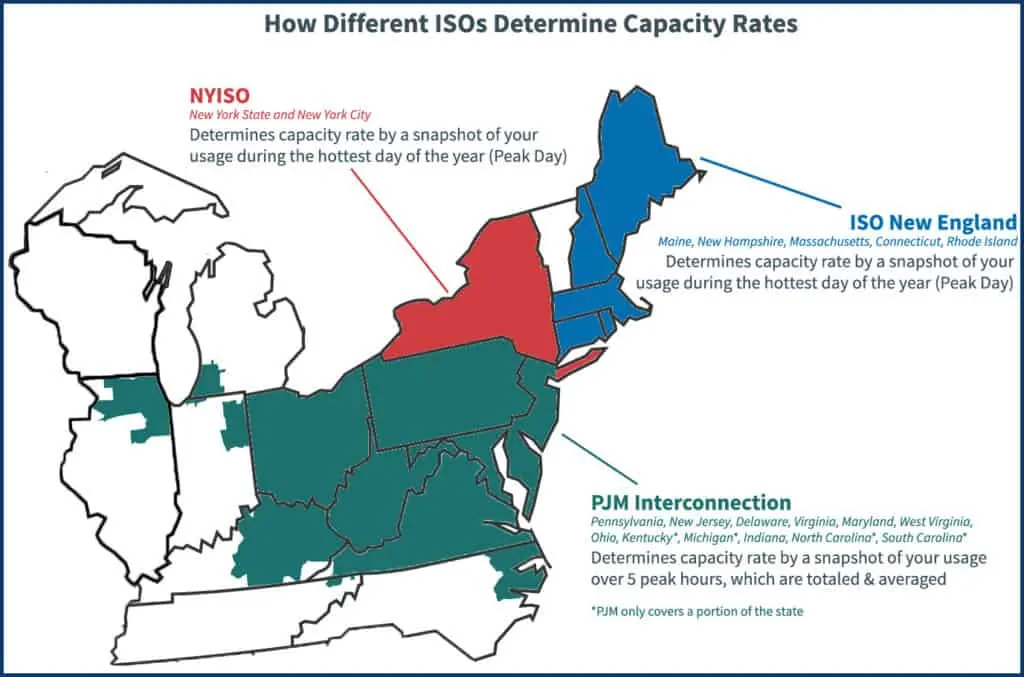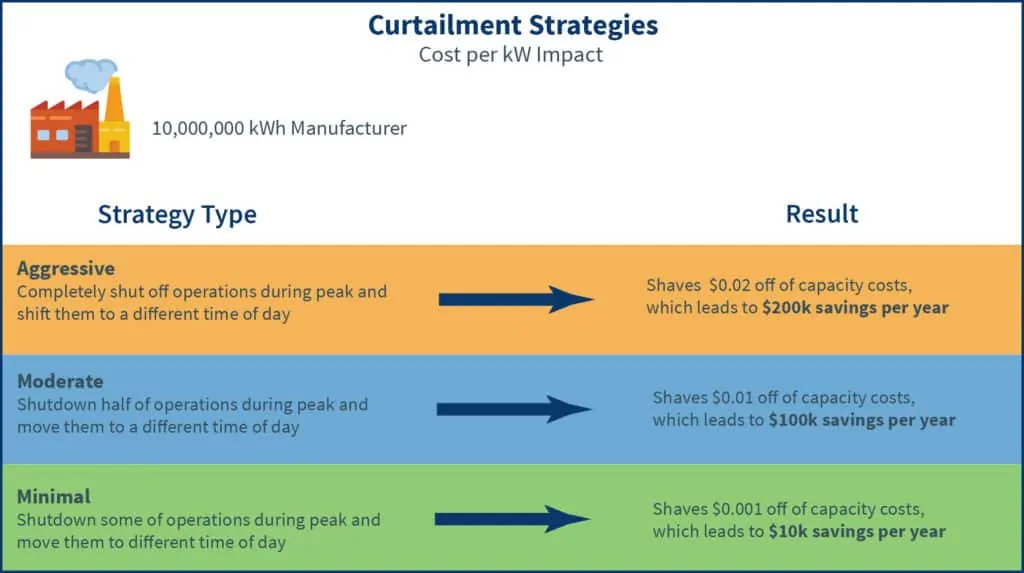One of the main tenets of our Whole Energy Health turnkey energy management solution is component strategy.
This is important because the secret sauce behind real cost avoidance on your energy bills is a well thought out and sophisticated strategy for each component of your price. While there isn’t necessarily a cost avoidance strategy for components like line losses or ancillary services other than just fixing them in, the cost associated with renewable energy, capacity, and energy can be strategically managed down.
The component strategy that helps to reduce your capacity costs is peak management, which is another tenet of Whole Energy Health. In short, peak management is the process of curtailing your usage during times of high demand on the grid (peak days) in order to lower your capacity tag for the following year.

One common capacity purchasing strategy employed to enable your business to perform peak management techniques is something called a capacity pass-through strategy.
Before diving into capacity pass-through, however, it is important to first understand how the dollar amount per kWh is calculated for capacity i.e. what you end up paying on your electricity bill.
How Capacity Cost is Calculated
The equation is simple:
Your Capacity Tag (ICAP Tag) x the Capacity Reserves Margin x the price paid for capacity at auction divided by your building’s usage.
A building’s capacity tag, which is set when demand on the grid is at its highest usually during sustained heatwaves on weekdays), is one of the biggest factors in your capacity price and is the part of it that you can control with peak load management.
Depending on your ISO location (see map below), your capacity tag is set during the highest peak hour (demand) of the highest peak day on the electricity grid each year. Your new capacity tag is issued in May of the following year and becomes effective on June 1st of the same year.
Another important concept to remember with capacity is this: Capacity tag curtailing is always a year behind, i.e. the rate you are paying (capacity tag) for capacity in 2020 is determined by your demand (kW) during the one hour electricity grid peak in 2019.

A Capacity Pass-Through Contract
Like any price component, capacity can be a fixed all-in price, which is perfect for many businesses who don’t have the budget flexibility or the type of operations to allow for curtailing loads.
For example, if you fixed your capacity costs for a 3-year contract back in 2018, you would be paying your capacity tag (or rate) that was captured in 2018 through the rest of your contract term, which ends in 2020. This is a strategy that is employed by many businesses, however, it doesn’t lend itself to managing capacity costs down.
If you were working with us on a new contract and we identified an opportunity for you to curtail such as an efficiency project, flexible operations, or a building addition, we would suggest something called a capacity pass-through contract.
With a capacity pass-through contract strategy, you are floating or passing your capacity costs through from the previous year in order to be able to curtail during the current year. You are technically ‘floating’ the cost, but are actually paying the true cost of your capacity i.e. last year’s capacity tag x the Capacity Reserves Margin x the price paid for capacity at auction divided by your building’s usage during the peak.
With this type of strategy, you are telling your supplier, “I’m going to pay my capacity tag costs that were set last year and am going to curtail my demand (measured in Kilowatts or kW) during peak events.”
Using an approach like this, you are only paying the ‘true-cost’ of the capacity costs you incur, avoiding any additional premiums by having your supplier forecast what your capacity tag might be year-over-year. As opposed to fixing the costs like described above, you would be floating capacity costs while still executing a hedging strategy for the other price components.
Advised for businesses looking to curtail, implementing this strategy during the first year of a new contract affords you the opportunity to lower your demand through peak load management during the first contract year, and, thus, your capacity tag, leading to lower rates. You would then continue to curtail each year of your contract while passing your capacity costs through.
A Capacity Pass-Through Contract in Action
Say it’s January 2018 and you just signed up for a 4-year contract that starts in February 2018. Before you contracted, however, we look at your operations and usage history and identify an opportunity to curtail your demand during the summer’s peak events.
Your capacity tag from 2017 is 200 kW and we think we can implement a strategy to manage that down for 2018. We help you implement a curtailment plan as well as get you into a capacity pass-through contract, which would have you paying or ‘passing through’ your capacity tag value and rate per kWh from 2017 (200 kW) for 2018.
When 2019 rolls around, after successfully curtailing your demand in 2018, your new capacity tag is set (on June 1st) at 100 kW because you were able to shave off 100 kW in costs.
Because you were so successful in your curtailment efforts, you would continue to curtail each remaining year of your contract to keep your peak demand and, thus, your capacity tag value consistent.

Shopping for Your Next Contract: Being Proactive Always Pays in Energy
Sometimes businesses want to curtail to manage their capacity costs down, but they are already in a fixed all-in contract for the next couple of years. How should they approach capacity management?
This brings to mind the old adage, ‘timing is everything.’
We always recommend shopping for your next energy contract years in advance, even while you’re in another contract, which is called managing your energy runway. This helps to better optimize your total energy costs.
In situations where businesses are already in a fixed all-in contract, but want be proactive and curtail to manage future contract capacity costs down, implementing a capacity pass-through strategy is a viable option. We always start with an audit to see if curtailment is a good idea for your business and if we can possibly restructure your current deal to allow for passing capacity through.
Here, we would help you develop a Peak Load Management plan for you to be able to implement for the last summer of your current contract. Then, after executing your curtailment plan during peak events, you would get a new capacity tag for the first year of your new contract that reflects your curtailed demand from the previous summer. You would continue to pass through your capacity costs and curtail your demand during the remaining years of your new contract to keep managing your capacity costs down.
Being Proactive in Action
For example, let’s say you started a 3-year, fixed all-in electricity contract in 2017 that ends in Jan 2020. In 2018, because you understand the importance of being proactive with your energy contracts, you’re shopping for your next contract that starts in 2020 and will go to 2023. We explain to you the benefits of curtailing and managing your capacity costs down and you become very interested in the prospect of doing so.
After performing a viability study where we look at your operations, usage, and backup generation options during which we analyze the operations cost of curtailing vs the economic upside, we determine that there is an opportunity for you to curtail. We work with you to design a curtailment plan that won’t be implemented until the final year of your current contract, 2019, so we can get you a lower capacity tag assigned for your new contract that starts in 2020 and ends in 2023.
Your capacity tag was 350 kW in 2017 and 340 kW in 2018 so you enact your strategy and curtail your demand in 2019. When your new contract starts in 2020, your new capacity tag comes back at 170 kW, which is what you will pay for the first year of your new contract. Discovering how successful curtailing was for your business in year one, you continue to curtail your demand during peak events throughout each year of the rest of your contract.
By taking a proactive approach toward your capacity management and ensuring you have the right solution in place for the future, you were able to significantly increase the value of your capacity tag for your new contract!
A well-thought out and proactive strategy for each of the components of your electricity price is vital to cutting costs on your bills. Due to the ability to curtail, the capacity component is one you have a good deal of control over.
By using a capacity pass-through strategy, you ensure that you’re not losing money on fixed costs, you allow your business the opportunity to curtail, and suppliers aren’t adding risk premiums to your capacity costs like they would with a fixed cost strategy.
Capacity is extremely complicated as there are many nuances that need to be understood in order to get the most out of your energy contract. That’s why you work with an energy consultant like us so we can help guide and navigate you through these convoluted waters so you can achieve maximum cost avoidance on your bills!
Contact us today to learn more about electricity price component strategies, capacity, and if peak load management strategies will be beneficial to your business!
